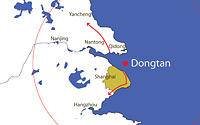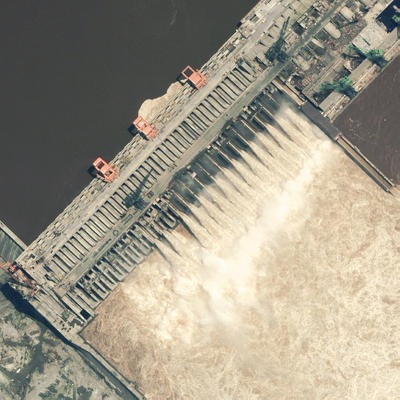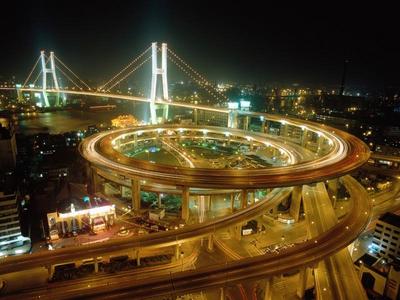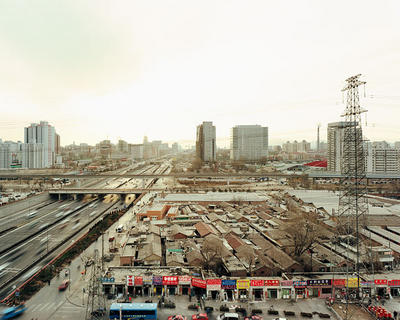Space in China

[Image: Causeway Bay I, Hong Kong, 2004, by Sze Tsung Leong.]
It was quietly announced, at the end of August, that Arup, the almost comically omnipresent British engineering firm, has won a multi-billion pound contract for the design, engineering, and construction of an entire city, to be built from scratch outside Shanghai in the Dongtan wetlands of eastern China.

[Image from Arup's website.]
The city – called, simply, Dongtan – will be "the world’s first genuinely eco-friendly city," the Times reports, "powered by renewable energy sources and as close to carbon-neutral as possible."
It "will eventually extend to cover some 8,800 hectares, roughly equivalent to New York’s Manhattan island" – though Arup, it seems, will only be planning an initial "630 hectares, roughly three times the size of the City of London."
Only.
Arup's own press release spells out their role in great detail: "Arup is responsible for the integrated master-planning of the built environment... providing a full range of services, including urban design, planning, sustainable energy management, waste management, renewable energy process implementation, economic and business planning, sustainable building design, architecture, infrastructure and even the planning of communities and social structures." (Which, latterly, sounds rather ominous.)
"Priority projects [will] include the process of capturing and purifying water in the landscape to support life in the city. Community waste management recycling will generate clean energy from organic waste, reducing landfills that damage the environment. Combined heat and power systems will provide the technology to source clean and reliable energy."
Compare that to the hum-drum initiatives under discussion now to rebuild New Orleans, and you can't help but conclude that the United States is in such an advanced state of structural decrepitude and urban-imaginative bankruptcy that opening up a few branches of CVS or a Ross Dress For Less somehow passes for successful urbanism.
Dongtan, Arup claims, "underline[s] the Chinese government’s move to take account of environmental considerations in future policy initiatives."
Whether or not such optimism is warranted, it is interesting to read such a statement in light of an article that appeared last night in The Guardian. Its author, Jonathan Watts, suggests that "a much bleaker future" is in store for China's nascent, super-powered, high-construction economy: "Environmentally and spiritually," Watts writes, "[China's rapid development] is a disaster. China's rivers are drying up, its cities are choked with pollution, the rural health-care system has collapsed and the cities are seeing record levels of suicide and stress. China is showing all the symptoms of modernity – only on a bigger scale and at a faster rate than the world has ever seen."
One could argue, however, that this increasingly catastrophic situation is exactly why the Chinese government now seeks to build a city like Dongtan.
In any case, Watts ends with a kind of prescription: "In the 19th century, Britain and Europe taught the world how to produce. In the 20th, the US taught us how to consume. If China is to lead the world in the 21st century, it must teach us how to sustain."
I would here hesitantly suggest that Arup's involvement with Dongtan perhaps offers an odd, if very real – if not, in fact, utopian – source of inspiration for urbanists, environmentalists, and BLDGBLOG contributors the world over. I just really, deeply, and profoundly hope, with unabashed, wide-eyed American sincerity, that Dongtan has at least one Ross Dress For Less.
Returning to Watts – well, returning to the subject matter that Watts is actually discussing: the new Chinese railway to Tibet (in the context of other Chinese infrastructural projects now under construction) – we find some truly astonishing descriptions.
For instance (taken, really, from a pay-per-view New York Times article): "For long stretches the [Tibet-bound] railway, which is fast nearing completion, will operate at altitudes higher than many small planes can fly, huffing and puffing far above the fragrant mists that roll down the Himalayan slopes. Indeed, the train, whose engines will need turbochargers just to get enough oxygen to run, will often soar above the clouds." (See also Archinect).
Or this, from Watts: "Luxury trains are being built for the new track. They feature pressurised carriages to minimise the risk of altitude sickness [!] and tinted windows to protect from strong ultra-violet rays. (...) The cars will be pulled by diesel engines capable of maintaining an average speed of 100 kph, even at above 4,000m, when the thinness of the air can cut power by almost half."
Then there's the awe-inspiring geotechnical challenge, which begs the question of whether human beings are even meant to be there in the first place (I would think not): the railway will cross "a vast sea of permafrost that stretches more than 600km across the [Qinghai] plateau towards Tibet and the Himalayas, prompting some to describe this area as the third pole of the world." This "third pole" is also known as the earthquake-prone Kunlun Pass, where "[e]ven the best Swiss tunnelling engineers concluded that it was impossible to bore through the rock and ice."
Watts continues: "There were 5,000m-high mountains to climb, 12km-wide valleys to bridge, hundreds of kilometres of ice and slush that could never support tracks and trains. How could anyone tunnel through rock at -30C, or lay rails when the least exertion sends you reaching for the oxygen bottle? But that's the sort of challenge today's China relishes."
China, indeed, is a nation of infrastructure.

[Image: Three Gorges Dam, the largest hydroelectric dam on the planet and "China's biggest construction project since the Great Wall," Watts writes.]
See, for instance, China's new highway system.

[Image: Shanghai gyratory (slideshow).]
From the BBC: "Every year China is constructing around 4,000 km of expressways, towards its target of connecting every city with a population of 200,000 or more to an 85,000 km national motorway network. Half the work is already done."
Will the Chinese produce their own Kerouac in 30 years? Riding the endless Chinese highways in a beat-up FAW, quoting St. Augustine and rewriting the Diamond Sutra?
Or will cars become obsolete just as China's national highway system is completed?
Come what may, a (now pay-per-view) article in the Engineering News-Record describes how, across bridges and inland piers, through tunnels and switchbacks, sinkholes and mines, across karst bedrock and the terrain of old wars, the Chinese highway system, come hell or high water – come permafrost or earthquakes – is being constructed.
So what's the point?
1) Several generations' worth of infrastructural planning and construction are occurring in China over the span of two decades.
2) The "eco-city" of Dongtan represents a positive model for urban design and development – shaming the United States, in particular, as libertarian pro-Bush anti-urbanists face having to rebuild New Orleans, in a flood zone, below sea level.
3) The Chinese highway and train systems, impressive enough (even if only on the level of national mythology), could have disastrous religious, cultural, and environmental impacts on the people of Tibet, the population of greater China – and perhaps on the global climate at large. This is something I've hardly even begun to discuss.
And yet it feels like the only real thing we can do for now is continue to watch space in China.

[Image: Beisihuanxi Lu, Zhongguancun, Haidian District, Beijing, 2004, by Sze Tsung Leong.]





Comments are moderated.
If it's not spam, it will appear here shortly!
While I only recently (in the past week) discovered your blog, I've been fascinated by about 90% of your entries, but I must say that this one is uniquly wonderous. The Tibetian sky train alone is positively mind-blowing! I would love to hear more about it in the months ahead!
Post a Comment